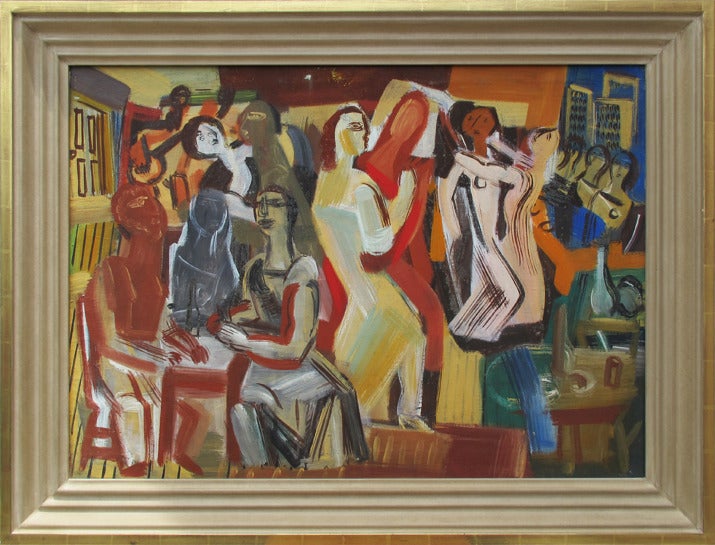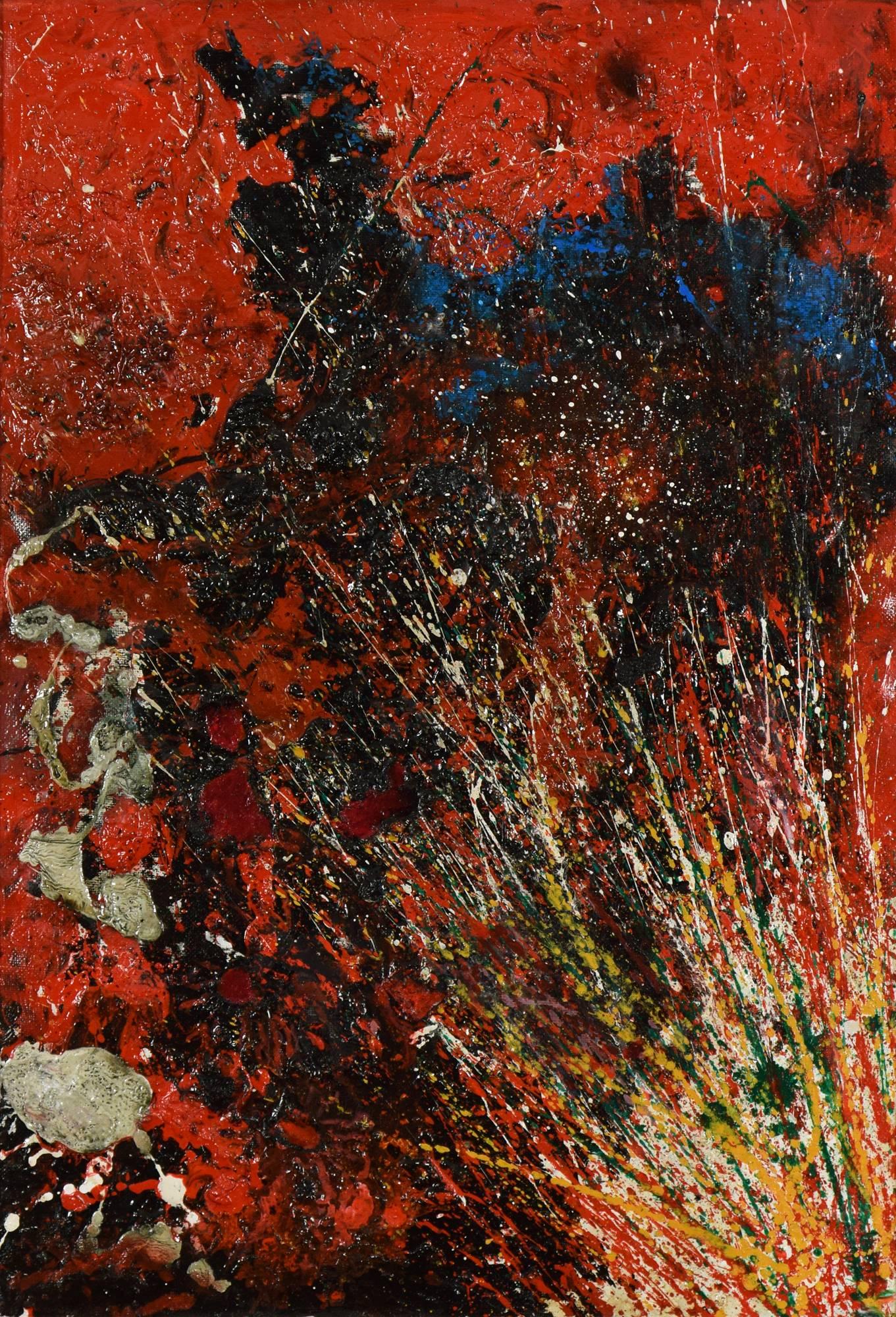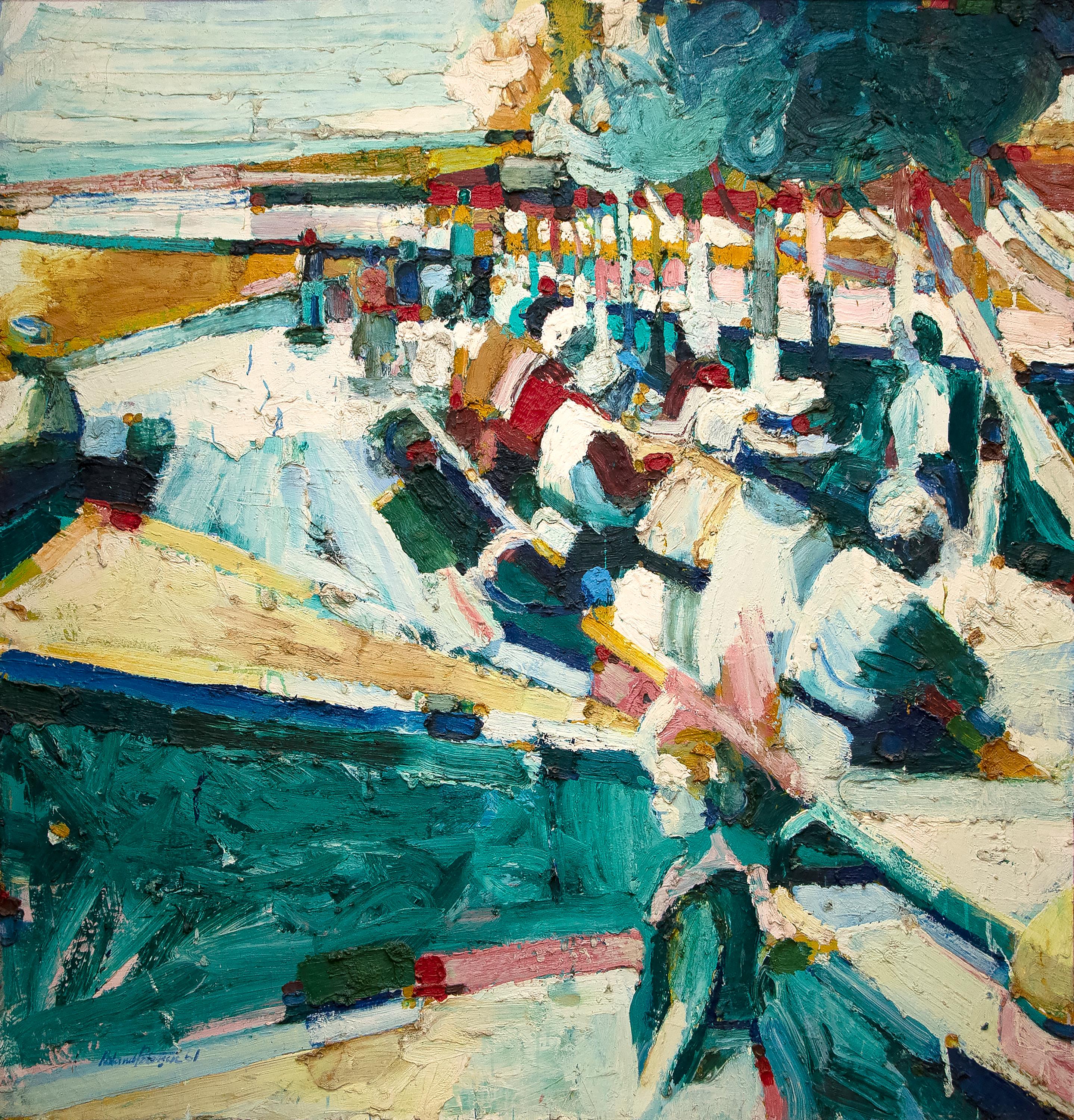Items Similar to Untitled
Video Loading
Want more images or videos?
Request additional images or videos from the seller
Paul BrachUntitled1951
1951
About the Item
Oil on canvas. Signed and dated lower right.
41.75 x 61 in.
44 x 63 in. (framed)
Custom framed in a hardwood floater with a matte white finish.
Provenance
Estate of the artist
Eric Firestone Gallery, New York
Born in New York, Paul Brach propelled American art forward through his own contributions as an Abstract Expressionist, Minimalist, art educator, and valued mentor. Brach grew up riding horses and working on ranches, experiences that influenced his work throughout his career. While studying at the University of Iowa under Grant Wood, Brach was called to the military and served in the U.S. Army as an infantryman for three years during World War II. After completing his formal art education and his first teaching experience in the Midwest, Brach returned to New York with his wife, the artist Miriam Schapiro.
Brach frequented the notorious Cedar Bar and quickly became associated with second-generation Abstract Expressionism, both socially and through his own interpretation of painterly abstraction.
In 1957, Leo Castelli opened his famed gallery at 4 East 77th Street on the Upper East Side. Brach was the third artist to enjoy a solo exhibition at Castelli Gallery, which ran from April to May of 1957. For the better part of the next decade, Brach would show with many of the artists who would come to be known as titans of the American post-war era: Willem de Kooning, Jackson Pollock, Morris Louis, Robert Rauschenberg, and many others.
In 1967, Brach moved to San Diego, accepting the offer to be chairman of the new art department at the University of California San Diego. Two years later, Brach moved on to the California Institute of Arts in Los Angeles, becoming the first dean of their art school. Integral to the program, Brach assembled an incredible faculty, which included Allan Kaprow, Nam June Paik, and Miriam Schapiro, while also fostering an environment in which artists like David Salle, Eric Fischl, and Jack Bloom could develop and flourish. Along with the educational renaissance Brach was leading, his studio practice evolved toward minimalism, with his paintings beginning to favor subtle palettes and quiet compositions.
In 1975, Brach and Schapiro returned to New York where he assumed the directorship of the Arts Division at Fordham University. Some years later, Brach eschewed academia in favor of a studio practice, which he maintained for the rest of his life.
Brach showed with various galleries until 1998, when he and Schapiro permanently relocated to East Hampton, where they remained until his death in 2007. Brach's work can be found in many public and private collections worldwide, including the Museum of Modern Art, the Whitney Museum of American Art, the Amon Carter Museum of Art, and the Smithsonian, among others.
Source: Eric Firestone Gallery
- Creator:Paul Brach (1924 - 2007, American)
- Creation Year:1951
- Dimensions:Height: 41.75 in (106.05 cm)Width: 61 in (154.94 cm)
- Medium:
- Movement & Style:
- Period:
- Condition:Overall good and stable condition. No evidence of restoration. Not examined under UV light. Please contact for full condition report and additional photos.
- Gallery Location:Austin, TX
- Reference Number:1stDibs: LU2287214215172
About the Seller
No Reviews Yet
Vetted Seller
These experienced sellers undergo a comprehensive evaluation by our team of in-house experts.
Established in 2020
1stDibs seller since 2023
- ShippingRetrieving quote...Ships From: Austin, TX
- Return PolicyA return for this item may be initiated within 30 days of delivery.
More From This SellerView All
- UntitledLocated in Austin, TXOil on canvas. Signed lower right. 50.5 x 38.25 in. 51.5 x 39 in. (framed) Custom framed in maple. Theodore Franklin (“Ted”) Appleby, Jr. was born January 28, 1923 in Asbury Park, New Jersey to a very prominent family in Monmouth County. He attended the Pauling School in New York and studied at the atelier of John Corneal. On December 12, 1942, Appleby enlisted in the U.S. Marine Corps, subsequently seeing action in the Marshall Islands. Upon the conclusion of the war, he was stationed for a year in Yokohama, Japan, where he studied local engraving techniques. In 1947, after returning home, Appleby moved to Mexico for a year to study mural painting in San Miguel de Allende. Following his sojourn in Mexico, Appleby briefly returned home to the U.S. before ultimately relocating to Paris. There, he joined a lively community of expatriate American artists involved with what would come to be known as the “School of Paris.” Appleby befriended fellow Americans Sam Francis and Jackson Pollock, exhibiting extensively throughout France with the former. He also regularly visited the atelier of Fernand Léger, and was represented in the "Salon de Réalités Nouvelles" and the “Salon d’Automne” during the 1950s and 60s. From 1955 to 1961, Appleby participated in group exhibitions in Chicago, Leverkusen (Germany), Lisbon, London, and Paris. He also had three notable solo exhibitions during this period: Studio Facchetti, Paris (1956); Martha Jackson Gallery, New York (1957); and the American Cultural Center, Paris (1959). In 1957, Appleby’s work was presented at the 62nd American Exposition of Painters and Sculptors at the Chicago Art Institute, where he was awarded the Norman Wait Harris Bronze Medal and Prize. Answering the famed artist André Lhote’s call to help save the village of Alba-la-Romaine in the Ardèche, Appleby and his wife - the artist Hope Manchester - purchased a home in the village in 1950, ultimately settling there until their deaths. Source: Taylor Graham GalleryCategory
1950s Abstract Expressionist Abstract Paintings
MaterialsCanvas, Oil
- UntitledBy Norman CartonLocated in Austin, TXOil on canvas. Signed lower right, signed and sequentially numbered on verso. 44 x 30.25 in. 47.5 x 33.75 in. (framed) Custom framed in a two-tiered matte white hardwood tray frame. Provenance Estate of Norman Carton Norman Carton was born in the Ukraine, eventually immigrating to the U.S. in 1922 and settling in Philadelphia, where he attended the Pennsylvania Museum School of Industrial Art. In the 1930s, he received a scholarship to attend the Pennsylvania Academy of Fine Arts (PAFA). Between 1939 and 1942, the Works Project Administration (WPA) employed Carton as a muralist. During World War II, Carton was a naval structural designer and draftsman at the Cramps...Category
1970s Abstract Expressionist Abstract Paintings
MaterialsCanvas, Oil
- Paysage aux RochersBy Gabriel GodardLocated in Austin, TXOil on canvas. Signed and dated lower left. 51 x 38 in. 52.5 x 39.25 in. (framed) Framed in maple. Gabriel Godard, a self-taught painter, was born in 1933 in Delouze, France. Hist...Category
1960s Abstract Expressionist Abstract Paintings
MaterialsCanvas, Oil
- Komposition rot/schwarzLocated in Austin, TXOil on canvas. Signed and dated lower left, inscribed label verso. 59.25 x 55.25 in. 61 x 57 in. (framed) Custom framed in a wooden double tray frame, hand-painted white. Provenance Galerie Lovers of Fine Art, Gstaad, Switzerland This work has been recorded under no. 1531 in the digital Catalogue Raisonné of the artist, prepared by Michel Reymondin, Montreux, Switzerland. Carl Walter Liner was born in the Swiss canton of Appenzell, near the border with Liechtenstein, in 1914. The son of famed artist Carl August Liner, the younger Liner enjoyed more critical and commercial renown for his landscapes. In 1938 at the age of 24, he undertook what would become the first of several residencies in Paris. This particular sojourn helped to establish the trajectory of his career, as Paris would provide the setting in which he became acquainted with early twentieth century masters Maurice de Vlaminck, Georges Braque, Ossip Zadkine, Gérard Schneider, and Erich Heckel. The stylistic and technical influence of his contemporaries is clearly evident in Liner’s work from this point forward. Unfortunately, the dawn of the 1940s would bring about a number of challenges for Liner. With the outbreak of war, Liner was mobilized for the Swiss Border Guard, and returned home to Switzerland in 1939. He remained on active duty until 1945, only to lose his father the following year. The death of the elder Liner left a profound impact on his son, who eventually made his way back to Paris in 1947 and embarked upon what would become a very successful series of nudes. By his own admission, 1948 was a pivotal year in Liner’s career, as a particularly spiritual trip to Algeria would foment the emotions led to the beginning of his practice with abstraction. Henceforth, Liner would vacillate between the figurative and abstract, creating parallel oeuvres. His abstraction from the 1950s and 60s mirrored...Category
1960s Abstract Expressionist Abstract Paintings
MaterialsCanvas, Oil
- UntitledBy Michael GoldbergLocated in Austin, TXOil, pastel, and paper collage on canvas. Signed and dated verso. 52.75 x 47.75 in. 54 x 49 in. (framed) Gilded floater frame. Provenance Compass Rose, Chicago Born Sylvan Irwin Goldberg in 1924 and raised in the Bronx, Michael Goldberg was an important figure in American Abstract Expressionism, who began taking art classes at the Art Students League in 1938. A gifted student, Goldberg finished high school at the age of 14 and enrolled in City College. He soon found New York’s jazz scene to be a more compelling environment, and he began skipping classes in favor of the Harlem jazz clubs near campus. Goldberg’s love of jazz would become a lifelong passion and a key component to his approach to composition in his paintings. From 1940 to 1942, like many of the leading artists of the New York School, Goldberg studied with Hans Hofmann. In 1943, he put his pursuit of painting on hold and enlisted in the U.S. Army. Serving in North Africa, Burma, and India, Goldberg received a Purple Heart and a Bronze Star before being discharged in 1946. After his service, he traveled and worked in Venezuela before returning to the United States, settling back in New York and resuming studies with Hofmann and at the Art Students League. Living downtown and frequenting the Cedar Bar, Goldberg befriended many of the artists of the New York School. In 1951, his work was included in the groundbreaking Ninth Street Show, co-organized by Leo Castelli, Conrad Marca-Relli, and the Eighth Street Club, and featuring the work of - among others - Hofmann, Jackson Pollock, Willem de Kooning, and Franz Kline. In 1953, the Tibor de Nagy...Category
1980s Abstract Expressionist Abstract Paintings
MaterialsCanvas, Pastel, Mixed Media, Oil, Handmade Paper
- July FourthLocated in Austin, TXOil on canvas. Signed and titled verso. 40.25 x 56.25 in. 40.75 x 56.75 in. (framed) Custom framed in a whitewashed cherry closed-corner frame. Aaron Levy was born in New York Cit...Category
1960s Abstract Expressionist Abstract Paintings
MaterialsCanvas, Oil
You May Also Like
- Diving for PearlsLocated in New York, NYDiving for Pearls, 1986 Oil on canvas 88 x 76 in. (223.5 x 193 cm) Signed, dated, and titled, versoCategory
1980s Abstract Expressionist Abstract Paintings
MaterialsCanvas, Oil
- James Joyce's SmileLocated in New York, NYJames Joyce's Smile, 1984 Oil on canvas 66 x 87 in. (167.6 x 221 cm) Signed, dated, and titled, versoCategory
1980s Abstract Expressionist Abstract Paintings
MaterialsCanvas, Oil
- Large Scale Mid-Century Earth-tone Horizontal Abstract by Joseph VasicaBy Joseph VasicaLocated in Soquel, CALarge Scale Mid-Century Earth-tone Horizontal Abstract by Joseph Vasica Very large scale (70"H x 160"W) (5.8'H x 13.3'L) mid-century abstract with soft edge, grey and burnt sienna...Category
Mid-20th Century Abstract Expressionist Abstract Paintings
MaterialsCanvas, Oil
- "Manhattan Night Life"By Vaclav VytlacilLocated in Lambertville, NJJim’s of Lambertville is proud to offer this artwork by: Vaclav Vytlacil (1892-1984) He was born to Czechoslovakian parents in 1892 in New York City. Living in Chicago as a youth, he took classes at the School of the Art Institute of Chicago, returning to New York when he was 20. From 1913 to 1916, he enjoyed a scholarship from the Art Students League, and worked with John C. Johansen (a portraitist whose expressive style resembled that of John Singer Sargent), and Anders Zorn. He accepted a teaching position at the Minneapolis School of Art in 1916, remaining there until 1921. This enabled him to travel to Europe to study Cézanne’s paintings and works of the Old Masters. He traveled to Paris, Prague, Dresden, Berlin, and Munich seeking the works of Titian, Cranach, Rembrandt, Veronese, and Holbein, which gave him new perspective. Vytlacil studied at the Royal Academy of Art in Munich, settling there in 1921. Fellow students were Ernest Thurn and Worth Ryder, who introduced him to famous abstractionist Hans Hofmann. He worked with Hofmann from about 1922 to 1926, as a student and teaching assistant. During the summer of 1928, after returning to the United States, Vytlacil gave lectures at the University of California, Berkeley, on modern European art. Soon thereafter, he became a member of the Art Students League faculty. After one year, he returned to Europe and successfully persuaded Hofmann to teach at the League as well. He spent about six years in Europe, studying the works of Matisse, Picasso, and Dufy. In 1935, he returned to New York and became a co-founder of the American Abstract Artists group in 1936. He later had teaching posts at Queens College in New York; the College of Arts and Crafts in Oakland, California; Black Mountain College in North Carolina; and the Art Students League. His paintings exhibit a clear inclination toward modernism. His still lives and interiors from the 1920s indicate an understanding of the art of Cézanne. In the 1930s, his works displayed two very different kinds of art at the same time. His cityscapes and landscapes combine Cubist-inspired spatial concerns with an expressionistic approach to line and color. Vytlacil also used old wood, metal, cork, and string in constructions, influenced by his friend and former student, Rupert Turnbull. He eventually ceased creating constructions as he considered them too limiting. The spatial challenges of painting were still his preference. During the 1940s and 1950s, his works indicated a sense of spontaneity not felt in his earlier work. He married Elizabeth Foster in Florence, Italy, in 1927 and they lived and worked in Positano, Italy for extended periods of time. Later on, they divided their time between homes in Sparkill, New York and Chilmark, Massachusetts, where Vyt, as he was affectionately called, taught at the Martha's Vineyard Art...Category
1930s Abstract Expressionist Abstract Paintings
MaterialsCanvas, Oil
- Red Composition by TOSHIMITSU ÏMAI - Contemporary, Abstract, Oil on canvasBy Toshimitsu ImaiLocated in London, GB*PLEASE NOTE UK BUYERS WILL ONLY PAY 5% VAT ON THIS PURCHASE. Red Composition by TOSHIMITSU ÏMAI (1928-2002) Oil on canvas 80.2 x 55.3 (31 ⅝ x 21 ¾ inches) Signed, TOSHIMITSU IMAÏ, dated, 1963 Paris and inscribed in Japanese on the reverse Provenance Private collection, USA Born in Kyoto, Japan in 1928 Imai was part of the 20th century Japanese avant-garde. He began his formal education at the Tokyo State Art Academy where he took up painting. His early works are characterised by colourful abstractions, reminiscent of Favuism. In 1951 Imai was awarded the Kansai-Shinseisaku Prize and in 1952 the prize for the best new artist at the 15th Shinseisaku Salon. Imai relocated to Paris in 1953, the same and subsequent year he exhibited at the Salon de L’Art Sacré. Meanwhile, he attended the Académie de la Grande Chaumière and the Sorbonne to read medieval history and philosophy. In 1955, Imai completely abandoned representational art in favour of abstraction. After meeting the art critic Michel Tapié via the artist Sam Francis, Imai was the first Japanese artist to join the Art Informel movement. In 1956 Imai was called upon by the Japanese artist Taro Okamoto to curate an exhibition entitled The World: Today’s Art in Tokyo. Artists such as Jean Dubuffet, Jean Fautrier, Lucio Fontana, and Karel Appel gained important exposure in Japan. It was also in 1957, when Imai arranged for Tapié and the artists Georges Mathieu and Sam Francis to travel to Japan, that a connection between Art Informel and Gutai occurred. The Ashiya-based Gutai Art Association formed in 1954 was proclaimed a kindred spirit by Tapié which he subsequently promoted internationally. Founding members included Yoshihara Jiro, Kanayma Akira, Murakami Saburo, Shiraga Kazuo and Shozo Shimamoto...Category
1960s Abstract Expressionist Abstract Paintings
MaterialsCanvas, Oil
- UntitledBy Roland PetersenLocated in Palm Desert, CAA painting by Roland Petersen. This Untitled, oil on canvas, abstract painting is executed in thick and lush impasto, in colors primarily of greens, blues, teals, white, red, ochre a...Category
1960s Abstract Expressionist Abstract Paintings
MaterialsCanvas, Oil





